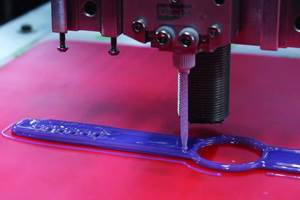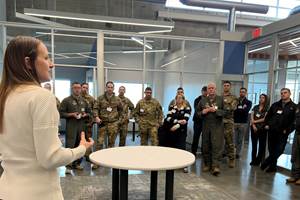Navy Improves Readiness of USS Bataan With 3D Printing Capability
Crew of USS Bataan completed the first metal 3D part fabrication and replacement for a de-ballast air compressor in only five days using a permanently installed metal 3D printer, demonstrating the impact this technology can have on operational readiness.
Share
The crew of USS Bataan (LHD 5), supported by the Naval Sea Systems Command (NAVSEA), completed the first metal 3D part fabrication and replacement for a de-ballast air compressor (DBAC) in only five days using its permanently installed metal 3D printer.
“This success story shows the self-sufficiency we can achieve when our sailors are provided with cutting-edge technology,” sayes Rear Admiral Joseph Cahill, commander, Naval Surface Force Atlantic (SURFLANT). “The impact technology like this can have on operational readiness, particularly in a combat environment where logistics capabilities will be challenged, is critically important.”
The part is a sprayer plate which is part of a DBAC that is used to force pressurized air through saltwater tanks and discharge the accumulated saltwater. The tanks are filled to lower a ship’s draft for amphibious operations. Producing the sprayer plate while at sea enabled the ship to mitigate the time spent obtaining a replacement assembly.
“Rapidly learning how to utilize AM shipboard and scaling these capabilities is a key enabler to us sustaining our platforms and weapons systems,” says Rear Admiral Jason Lloyd, deputy commander for NAVSEA’s Naval Systems Engineering and Logistics Directorate. “I am excited to see how Bataan embraced this technology to enhance readiness at the point of need.”
The printer was installed as part of a joint effort between SURFLANT and the NAVSEA Technology Office. It includes the Phillips Additive Hybrid system, which integrates a Meltio 3D laser metal wire deposition head on a Haas TM-1 computer numerical control mill. The Navy says the Haas TM-1 platform has been proven to operate reliably in an afloat environment aboard several aircraft carriers. Integrating the Meltio 3D deposition head with the Haas TM-1 provides both an additive and subtractive manufacturing capability within the same system, thereby increasing efficiency and reducing waste when compared with typical machining.
The repair effort was led by Machinery Repairman First Class Mike Hover and began by creating a computer aided design (CAD) model of a sprayer plate from a functional sprayer plate from one of the ship’s other DBAC systems. After creating a preliminary CAD model, Hover leveraged NAVSEA’s ‘Apollo Lab’ construct which was established for engineering and fleet support and training.
NAVSEA established the “Apollo Lab” in 2018 for engineers to better support forward-deployed sailors. The Apollo Lab — led by NAVSEA field activity Naval Surface Warfare Center, Carderock Division, Johns Hopkins University Applied Research Laboratory (JHU APL) and Building Momentum — provides distributed, reach-back engineering support by civilian engineers for AM equipment. Apollo Lab also supports the fleet by designing AM components to be made by sailors at sea.
Bryan Kessel, a mechanical engineer at Naval Surface Warfare Center, Carderock Division, refined the CAD file, worked with JHU APL to develop the software instructions to guide operation of the metal 3D printer and securely transferred those instructions back to the ship to produce and install the sprayer plate.
NAVSEA is the largest of the Navy’s six system commands, responsible for the procurement, maintenance and modernization of ships, submarines and systems for the U.S. Navy. NAVSEA’s Technology Office is leading multiple areas of research and development in evaluation of AM equipment, using data not only from deployed assets but also shore side lab activities, to gain a critical understanding of how the equipment will perform under shipboard conditions. These evaluations will ensure that the current and future shipboard implementations of this equipment are fabricating parts repeatedly and reliably, thus enabling sailors to address an increasing number of applications.
Related Content
JuggerBot 3D Awarded $4 Million by Air Force to Develop Large Format Hybrid Additive System
The project focuses on advancing the ability to print a thermoset composite material that can transform the way an aircraft structure is designed, fabricated and sustained for limited-life aircraft.
Read MoreHow a DOD-Funded Resilient Manufacturing Ecosystem (RME) Is Coming Together at Neighborhood 91
Pittsburgh’s additive manufacturing campus doubles as a test bed for a Department of Defense project aimed at developing a reproducible ecosystem for on-demand production of critical parts.
Read MoreSintavia Develops Niobium Printing Technology for Aerospace, Defense
C103 material parameter specification is said to enable full alloy adoption across defense and space applications.
Read MoreAt General Atomics, Do Unmanned Aerial Systems Reveal the Future of Aircraft Manufacturing?
The maker of the Predator and SkyGuardian remote aircraft can implement additive manufacturing more rapidly and widely than the makers of other types of planes. The role of 3D printing in current and future UAS components hints at how far AM can go to save cost and time in aircraft production and design.
Read MoreRead Next
4 Ways the Education and Training Challenge Is Different for Additive Manufacturing
The advance of additive manufacturing means we need more professionals educated in AM technology.
Read MoreAt General Atomics, Do Unmanned Aerial Systems Reveal the Future of Aircraft Manufacturing?
The maker of the Predator and SkyGuardian remote aircraft can implement additive manufacturing more rapidly and widely than the makers of other types of planes. The role of 3D printing in current and future UAS components hints at how far AM can go to save cost and time in aircraft production and design.
Read More3D Printing Brings Sustainability, Accessibility to Glass Manufacturing
Australian startup Maple Glass Printing has developed a process for extruding glass into artwork, lab implements and architectural elements. Along the way, the company has also found more efficient ways of recycling this material.
Read More






















